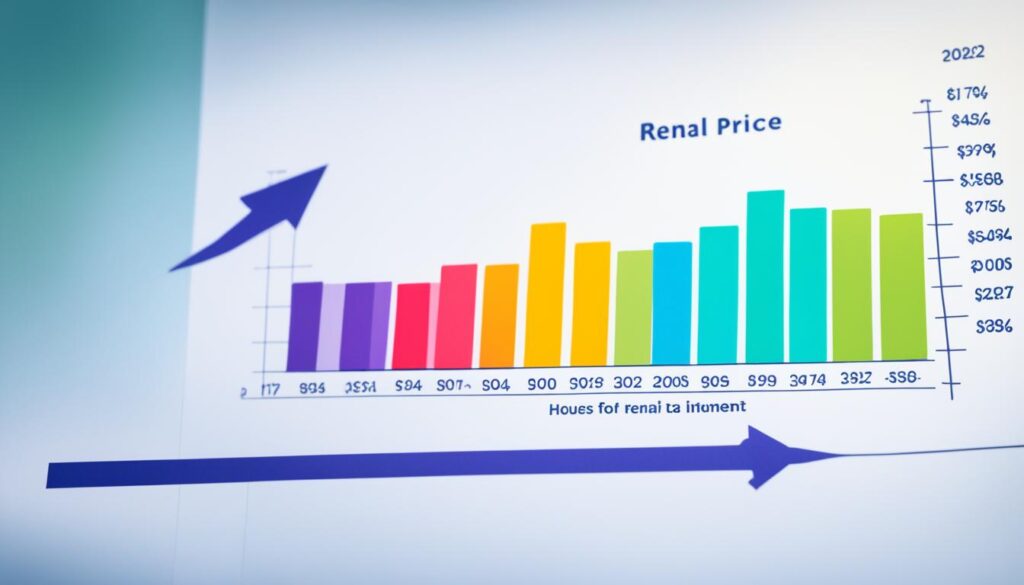
Real estate investment analysis is a crucial element of any successful investment strategy. It involves evaluating the current performance of investment properties and identifying areas for improvement. By performing detailed analysis, investors can calculate key metrics such as cap rate, NOI, cash-on-cash return, and total return. This analysis helps investors make informed decisions and maximize their returns in the real estate market.
If you’re new to real estate investment or looking to expand your portfolio, understanding the fundamentals of investment analysis is essential. In this article, we’ll simplify the process and provide you with valuable insights and tips for making profitable property investments.
Key Takeaways:
- Property investment tips: By analyzing investment properties, investors can identify potential opportunities for wealth building and passive income.
- Rental property advice: Thorough analysis of rental properties helps determine potential cash flow and return on investment.
- Real estate market trends: Investment analysis provides a deeper understanding of prevailing market conditions, allowing investors to make strategic decisions.
- Portfolio diversification: Through investment analysis, investors can determine the viability of adding different types of properties to their real estate portfolio.
- Beginner-friendly insights: This article covers the basics of real estate investment analysis, making it accessible to beginners in the field.
Types of Investment Properties in Real Estate
When it comes to analyzing investment properties, understanding the different types of properties available is essential. Two common types of investment properties in real estate are single-family homes and multi-unit properties.
Single-Family Homes
Single-family homes are residential properties consisting of a single dwelling unit. These properties are typically occupied by one family or household. When evaluating the value of single-family homes, real estate investment analysis relies on market comps, which are nearby properties with similar characteristics. The value of single-family homes tends to rise when similar homes in the area experience appreciation.
Multi-Unit Properties
Multi-unit properties, on the other hand, are residential properties consisting of multiple separate units within a single building or complex. These properties generate income through rental payments from tenants. Unlike single-family homes, the value of multi-unit properties is primarily based on their income potential. Factors such as cash flow and appreciation play a significant role in determining the value of multi-unit properties.
Real estate investment analysis is crucial for accurately determining the value of both single-family homes and multi-unit properties. By analyzing property values, cash flow projections, and appreciation potential, investors can make informed decisions to maximize their returns in the real estate market.


Gathering and Analyzing Property Data for Investment Analysis
Before conducting a thorough investment analysis, investors must gather essential property details for accurate assessment. This includes information such as the number of units, square footage, and property design. By examining these details, investors can evaluate the property’s suitability for their investment goals.
Purchase information is another critical component of the analysis process. Investors need to collect data regarding the total purchase expenses and financing details, including the down payment amount, interest rates, and loan terms. This information helps investors understand the financial implications of the investment and calculate the potential return on investment.
When analyzing property data, income sources play a vital role. It is important to collect information about current rental income, lease agreements, and any additional income generated from the property, such as parking fees or laundry facilities. This data helps determine the property’s income potential and its impact on the overall investment strategy.
Expenses are essential factors to consider in investment analysis. Investors should gather data on expenses such as insurance, property taxes, mortgage interest, utilities, and maintenance costs. By accurately accounting for these expenses, investors can calculate the property’s net operating income (NOI), cash flow, and potential profitability.
By compiling and analyzing this property data, investors can gain a comprehensive understanding of the property’s financial performance. This real estate investment analysis helps investors make informed decisions and maximize their returns in the real estate market.
The importance of property details
Gathering accurate property details is crucial for real estate investment analysis. These details provide valuable insights into the property’s characteristics, potential risks, and income-generating potential. Investors should take into account the property’s location, condition, amenities, and any unique selling points that may affect its market value and rental potential.
In addition, evaluating the historical and projected market trends in the property’s location can help investors assess its long-term profitability and growth potential. This analysis may include factors such as job growth, population trends, and development plans in the area.
By paying close attention to property details and conducting thorough investment analysis, investors can make informed investment decisions and maximize their chances of success in the real estate market.


Key Metrics for Rental Property Analysis
When it comes to analyzing rental properties, there are several key metrics that investors need to consider. These metrics provide valuable insights into the financial viability of a property and its potential returns. Let’s take a closer look at these metrics:
The Net Operating Income (NOI)
The Net Operating Income (NOI) is a critical factor in rental property analysis. It represents the total income generated by a property after deducting the expenses. By calculating the NOI, investors can gauge the property’s profitability and cash flow potential.
Property Income and Expenses
Determining the property’s income and expenses is essential in understanding its financial performance. Property income includes tenant rent payments and other sources of revenue, while expenses encompass costs such as insurance, taxes, mortgage interest, utilities, and maintenance. By carefully analyzing these income and expense figures, investors can assess the property’s overall financial health and make informed investment decisions.
Cash Flow, Rate of Return, and Capitalization Rate
Calculating the cash flow, rate of return, and capitalization rate are essential steps in rental property analysis. Cash flow represents the amount of money generated by the property after all expenses are paid. It provides insight into the property’s profitability and potential for generating positive cash flow.
The rate of return measures the return on investment (ROI) and is calculated by dividing the property’s net operating income by its total investment cost. It helps investors assess the property’s potential returns and compare it with other investment opportunities.
The capitalization rate, often referred to as the cap rate, is another important metric in rental property analysis. It is calculated by dividing the property’s net operating income by its purchase price or market value. The cap rate helps investors determine the property’s value and potential for generating income.


By considering these key metrics in rental property analysis, investors can gain a comprehensive understanding of a property’s financial viability and potential returns. These metrics serve as valuable tools for making informed investment decisions and maximizing profitability in the real estate market.
Real Estate Valuation Methods
Real estate valuation plays a crucial role in determining the economic value of an investment property. By understanding the various valuation methods, investors can make informed decisions and assess the potential returns of their investments. Here are some key methods commonly used in real estate valuation:
The Capitalization Rate
The capitalization rate is a fundamental metric used to value income-producing properties. It is calculated by dividing the property’s Net Operating Income (NOI) by its market value. The capitalization rate represents the property’s potential return on investment and helps investors determine its value in the market.
Discounted Cash Flow Analysis
Discounted cash flow analysis is another essential method used in real estate valuation. It forecasts the property’s value based on the projected future NOI. By discounting the expected cash flows to their present value, investors can assess whether the property’s potential returns meet their investment goals.
Common Valuation Approaches
In addition to the capitalization rate and discounted cash flow analysis, several commonly used approaches help calculate the capitalization rate and estimate property value:
- The Build-up Method: This method estimates the capitalization rate by evaluating the risk associated with the property’s income stream and various factors such as market conditions and financing costs.
- The Market-Extraction Method: Using market data of recently sold properties with similar characteristics, this method determines the capitalization rate by comparing the income generated by the subject property to market trends.
- The Band-of-Investment Method: This approach considers both the debt and equity components of a property’s financing. It calculates the capitalization rate based on the weighted average cost of debt and equity for the investor.
These valuation methods enable investors to gain a comprehensive understanding of an investment property’s potential returns. By incorporating these analyses into their investment property analysis, investors can make informed decisions and maximize their success in the real estate market.


The Benefits of Property Management in Real Estate Investments
Hiring a property management company can provide numerous benefits for real estate investors. Property managers play a crucial role in ensuring the smooth operation of rental properties. They are responsible for day-to-day maintenance and administrative tasks, relieving investors of the burden of managing their properties themselves.
In addition to handling routine tasks, property managers also bring valuable insights and expertise in investment property analysis. They have a deep understanding of the local real estate market, allowing them to accurately assess rental property values and rental rates. This knowledge helps investors maximize their returns and make informed decisions when acquiring or selling investment properties.
Professional property management services go beyond property maintenance and analysis. They offer comprehensive rental management solutions, taking care of tenant screening, lease agreements, rent collection, and property marketing. By outsourcing these responsibilities to professionals, investors can enjoy a hassle-free experience and focus on expanding their real estate portfolio.
FAQ
What is real estate investment analysis?
Real estate investment analysis is the process of evaluating the financial performance of investment properties. It involves calculating key metrics such as cap rate, NOI, cash-on-cash return, and total return to make informed investment decisions.
What types of investment properties are there in real estate?
There are two main types of investment properties in real estate: single-family homes and multi-unit properties. Single-family homes are valued based on market comps, while multi-unit properties are valued based on their income potential.
What data should be gathered for investment analysis?
Relevant data for investment analysis includes property details, purchase information, financing details, income sources, expenses, and maintenance costs. This data provides a comprehensive understanding of the property’s financial performance.
What are the key metrics for rental property analysis?
Key metrics for rental property analysis include net operating income (NOI), property income, expenses, cash flow, rate of return, and capitalization rate. These metrics help determine the property’s financial viability and potential returns.
What are the methods used for real estate valuation?
The methods used for real estate valuation include the capitalization rate, discounted cash flow analysis, and net operating income. These methods help investors determine the economic value of an investment property.
What are the benefits of property management in real estate investments?
Hiring a property management company can provide numerous benefits for real estate investors. Property managers assist with day-to-day maintenance and administrative tasks, offer expertise in investment property analysis, and provide comprehensive rental management solutions.









